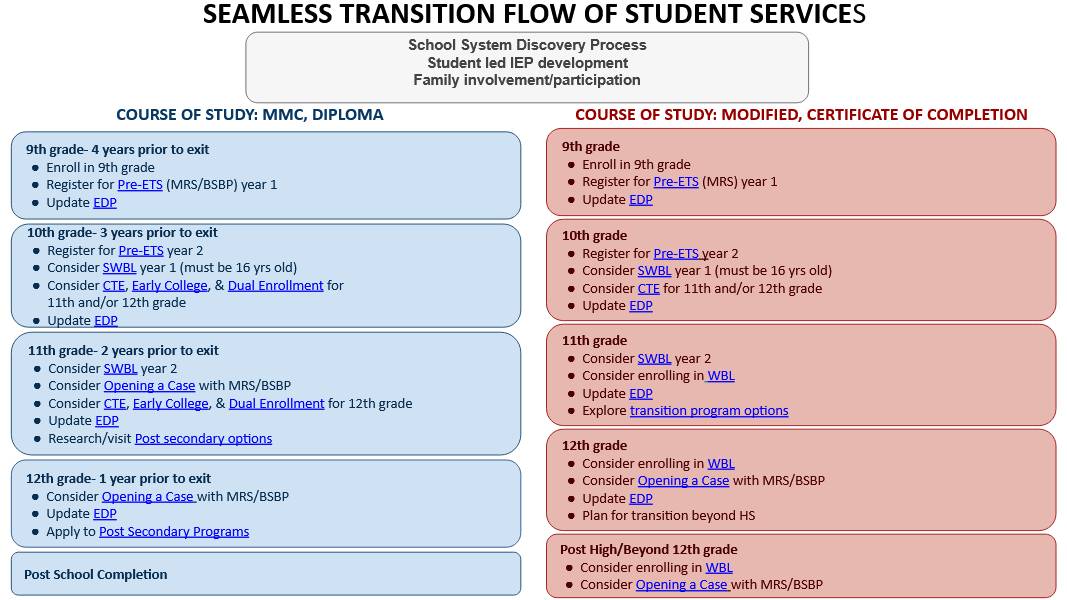There are several considerations pertaining to Education and transition planning. It is important school teams, including the target student, learn about and develop a Course of Study designed to achieve the student’s visions for employment, further education, and adult living. It also ensures there is a coordinated set of activities that facilitates movement from school to post-school activities. Coordination is also important to assure alignment between each of the components of the Transition IEP (age-appropriate transition assessments, summary of findings, postsecondary goals) with the activities and services that support the student’s development of, movement toward, or changing of their postsecondary goals. The following are resources and activities which provide more information and context on course of study and transition services.
Seamless Transition Flow of Services (Tool)
Seamless Transition Flow of Services (Tool): Provides guidance and links to transition planning activities.
Related Learning Activities:
- Use this tool as guidance through the Transition Services and the IEP activities
- Review required Course of Study for diploma or modified/certificate of completion by grade level
- Review and become familiar with requirements by grade (9-12):
- Diploma Track: Michigan Rehabilitation Services (MRS) or Bureau of Services for Blind Persons (BSBP) Pre-Employment Transition Services (pre-ETS), School Work Based Learning (SWBL), Career and Technical Education (CTE), Early College, and Dual Enrollment options, Educational Development Plan (EDP), engaging with MRS/BSBP Vocational Rehabilitation
- Certificate of Completion track: pre-ETS, CTE, SWBL, EDP, SWBL/WBL, engaging MRS/BSBP
Course of Study
The Course of Study is designed for the student to achieve their visions for employment, further education, and adult living.
Related Learning Activities:
- Review What is Course of Study? (from Michigan Alliance for Families).
- Download and review the Zarrow Center Student Directed Transition Planning: Course of Study presentation. This presentation provides examples and practice opportunities.
Transition Services
Coordination of movement from school to post-school activities is important because it ensures that there is alignment between each of the other components of the Transition IEP (age-appropriate transition assessments, summary of findings, postsecondary goals) with the activities and services that support the student’s development of, movement toward, or changing of their postsecondary goals.
Related Learning Activities:
- Review What are Transition Services? (from Michigan Alliance for Families and Oregon’s Transition Resource Book).
- Download and review the Zarrow Center’s Transition Services Plan Worksheet.
- Work through the worksheet with 1-2 transition age students.
- Download and review the Indiana University Student Transition Planning Folder.
- Work through each of the post-school areas for 1-2 students currently involved in Transition Planning.
- Go to Zarrow Center Resource Page: Curriculums
- There are several curriculums listed on this page. Scroll down to the Student-Directed Transition Planning curriculum (includes 8 lessons with teaching materials and lesson activities; Transition Knowledge Test; Pre and Post Measurement Tools for the student, parent, and teacher. Zarrow Center estimates 15 hours to complete 8 lessons)
- Consider how this curriculum, or portions of the curriculum, could be used in your transition program.
Family Engagement
Transition Planning
- Center for Parent Information: Transition to Adulthood
- Michigan Alliance for Families: Transition to Adulthood Topics
- Michigan Department of Education (MDE), Office of Special Education (OSE): Family Matters: Transition Planning
- National Center for Learning Disabilities (NCLD): A Comprehensive Support Program for Individuals with Learning Disabilities
- PACER’s National Parent Center on Transition and Employment
- Transition TN: Family Resources
Education and the IEP
- Center for Parent Information: Transition Goals in the IEP
- Michigan Alliance for Families: Transition IEP
- Michigan Department of Education (MDE), Office of Special Education (OSE): Family Matters: Transition Planning
- National Technical Assistance Center on Transition-The Collaborative (NTACT-C): Secondary Transition-Measurable Postsecondary Goals
- PACER Center: My IEP Owner’s Manual
- Transition TN (login required to access resources): Addressing Transition in the IEP and Navigating Easy IEP
- Understood: What is IEP Transition Planning?

